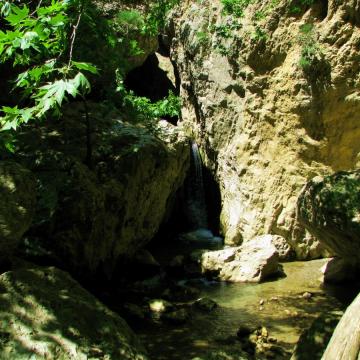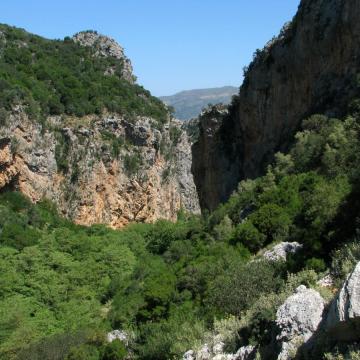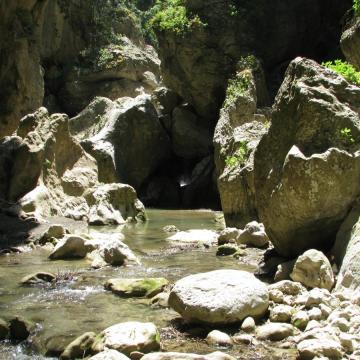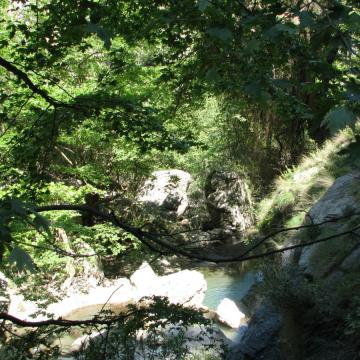GR4330004 - PRASSANO FARANGI - PATSOS - SFAKORYAKO REMA - PARALIA RETHYMNOU KAI EKVOLI GEROPOTAMOU, AKR. LIANOS KAVOS - PERIVOLIA
Map
Photos of the site
Quality
The importance of the site lies mainly on the variety of terrestrial and marine biotopes that give rise to a significant biological diversity. In particular, the elements that comprise the ecological quality and importance of the site are:1) A variety of natural well structured and mostly well conserved vegetation types.In particular, the mattoral of Querqus coccifera, especialy at the southern part of the site but also in some patches elsewhere is at a very good conservation status in comparison with other mattorals in Crete and many species of the flora of the maquis vegetation are represented very well in it.2) The cliffs of the site host a large number of species, mainly of the typical chasmophytic flora. For example Origanum dictamnus (included in Annex II of the Directive 92/43/EEC) as well as the species of plants listed on section "other important species" are found at the gorge of Prases. Some of the species listed on the section of "other important species" are endemic to Greece and some of them endemic to Crete; 2 species are endemic to Crete and Karpathos, and Erysimun candicum ssp. candicum is endemic to Crete, Karpathos and the Cyclades.3) There are a lot of caves but their fauna is not adequatelly known yet. The endemic Cretan species Troglophyllus spinulosus (order Orthoptera) has been reported in the site. Also, two endangered species of bats have been recorded at the caves near Mylli.4) The Molluscs of the site are interesting: some species of endemic Cretan terrestrial snails have been recorded in the area (section 3.3).5) The monk seal, Monachus monachus, has been recorded at the marine area of the eastern part of the site. There are some underwater caves at the coast between the beach of Scaletta and the mouth of Geropotamos river, which form appropriate habitats for this endagered species.6) Caretta caretta, an endagered species of sea turtle, uses the beach of Rethymnon to nest. The beach from Perivolia to Scaletta is one of the three most important nesting beaches in Greece and one of the most important in the Mediteranean sea. A mean of 410 nests per nesting season were reported after a five year monitoring project by the Sea Turtle Protection Society of Greece. A significant percentage of the nests in the known nesting beaches in Greece are found here. The nesting density is also very high (average more than 35 nests per Km). Nests of the sea turtle have also been recorded at the small beach of Geropotamos mouth.7) The gorge of Prases and the surrounding area have been recognised as a very good biotope for reptiles. Mauremis caspica is also found in good numbers at the wetland of Geropotamos. Elaphe situla and Mauremis caspica and some more species (listed on section 3.3), all rare and legally protected at national and international level and occurring at the site. With the exception of Tarentola mauritanica and Hemidactylus turcicus, all the others are found in the site at the borders of the species distribution. 8) All the amphibians of Crete, which are threatened and protected species, are found in the site. Bufo viridis is quite common in the area. Hyla arborea kretensis is a narrow endenic of Crete.9) All the Mammals occurring in the site (section 3.3) are legally protected. Meles meles arcalus is narrow endemic of Crete, included in the National Red Data Book. Also, Rhinolophus ferrumequinum creticum (included in section 3.2.c. as Rhinolophus ferrum-equinum) is a subspecies endemic to Crete.10) The avifauna is also important: Many species of birds have been recorded at the site. Most of them are migratory species. The wetland of Geropotamos is a very important area for them, especialy for Craradriformes, Herons and some Passeriformes. Alcedo atthis, which is a species protected by Annex I of the Directive 79/409/EEC, passes through the shores in big numbers. A colony of Gyps fulvus at the gorge of Prases and the presence of Hieraaetus fasciatus have also been recorded in the site.11) The site combines the ecological importance with archaeological, historical and aesthetic value. Such sites of interest are the village Maroulas, which is an important and rare example of the Middle Ages architecture in Crete, the old water mills at the now uninhabited old village Kato Myli, an example of a traditional use of the water in Crete, are still maintained.OTHER IMPORTANT SPECIES WITH MOTIVATION DPlants: Centaurea redempta, Ferulago thyrsiflora, Lomelosia albocincta (included in 3.3. by its synonym Scabiosa labocincta), Medicago strasseri, and Sesleria doerfleri are protected by Greek Law (Presidential Decree 67/81). Medigago strasseri is also included in the CORINE checklist of threatent plants.Lactuca acanthifolia (= Scariola acanthifolia) is found in Ydra, Cyclades, East Aegean Islands and only in SW Turkey out of Greece. Reptiles: All the species listed on section 3.3. are protected by the Greek Law (Presidential Decree 67/81) and by the Bern Convention, six some of them included annex II, strictly protected, and Tarentola mauritanica and Hemidactylus turcicus included in annex III. Natrix tesselata is included in the CORINE checklist of threatent animals. Amphibians: Bufo viridis and Hyla arborea kretensis are protected by the Greek Law (Presidential Decree 67/81) and by the Bern Convention.Mammals: Meles meles, Martes foina, Crocidura suaveolens, Erinaceus concolor (Synonym: Erinaceus europeus) and Mustela nivalis are protected bythe Bern Convention (annex III). The latter three are also protected by the Greek Law (Presidential Decree 67/81).
Other characteristics
The area is located at the nothern part of Crete on the south-east of Rethymnon town. It comprises the stream Sfakoryako, its tributaries and their valleys and the gorges of Prasses (Prassiano) and Agios Antonios Patsou. It is surrounded by many hills and low mountains, named Angoli, Soros, Angathi, Veni koryfi, Mavrou koryfi, and Gasparis. The coastal part of the site strats at 3 km east of Rethymnon and extends up to the cape Lianos kavos including a sea belt delimited by the depth curve of depth 50m (Posidonia belt). Finally, it includes the small wetland system of Geropotamos river, a narrow belt from cape Lianos to the interior. The site is characterized by various vegetation types changing from one part to the other and by diverse vulnerability, as most of the human activities are limited at the coastal area. Matorrals of Querqus coccifera and phryganas cover most of the terrestrial part of the site. Other characteristic vegetation is the Oleo-Ceratonium mattoral on the northwest part, a forest of Querqus ilex at the entrance of Patsos gorge, and the gallery of Salix at the banks of the Sfakoryako stream. There is also riparian vegetation with common perrenials or annuals (the vegetation of a constantly flowing mediterranean river with gravel bed, usually pebbles, a habitat type not included in Annex I). The cultivated land is located mostly around the villages and the valley. NOTE: 5331, Euphorbia dendroides is a rare species of the phrygana in the area. Only spots were found close to Prassa village with bushes of 10 to 30 years old. Overgrazing is a serious threat for this community.
Documentation
1) Kypriotakis Z. Unpublished data.
2) Margaritoulis D. & M. Dretakis. 1991. Determination of nesting habitats of Caretta caretta in Greece. Final report to the EEC, October 1991.
3) Patras University - Ministry of Environment, Physical Planning and Public Works. 1988. (Work Team: Economidou E. et al) Entopismos kai meleti ton ygroviotopon kai allon simantikon gia tin ornithopanida viotopon tis Kritis (Localization and study of wetlands and of other important for the birdfauna biotopes of Crete). Final report, Vol. 1, Patra. p. 384.
4) Paragamian K. Unpublished data.
5) Sea Turtle Protection Society of Greece. Unpublished data.
6) Vardinoyannis K., 1994. Biogeografia ton cherseon malakion sto notio nisiotiko aigaiako toxo (Biogeography of land snails in the south Aegean arc). Ph.D. Thesis, Univerity of Athens.
7) Georghiou K. 1995. Checklist of Endemic, Rare and Threatened Plants of Greece. Draft. University of Athens. (3.3, 3.4, 4.2)
8) Morgan V & C. Leon. 1992. Datasheets of Flora species for revision of Appendix I of the Bern Convention. Volume IV. endemic taxa of Cyprus, Greece and Turkey Nature and environment. Nature and Envrionment. No 63 p. 106. Council of Europe, Publishing and Documentaion Service, Strasbourg. (3.2.g.)
9) Grimmet R.F.A. & T.A. Jones. 1989. The Important Bird Areas in Europe. ICBP Technical Publication No. 9, p. 906. (3.2. a).
10) [CORINE BIOTOPES] (3.2. a, b).
Reference: Natura 2000 data form, database release 7 Feb 2014






